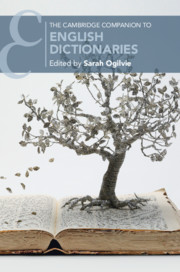Book contents
- The Cambridge Companion to English Dictionaries
- The Cambridge Companion to English Dictionaries
- Copyright page
- Dedication
- Contents
- Illustrations
- Tables
- Notes on Contributors
- Acknowledgements
- Chronology
- Chapter 1 Introduction
- Part I Issues in English Lexicography
- Chapter 2 How a Word Gets into an English Dictionary
- Chapter 3 Technology and English Dictionaries
- Chapter 4 Diachronic and Synchronic English Dictionaries
- Chapter 5 Description and Prescription: The Roles of English Dictionaries
- Chapter 6 European Cross-Currents in English Lexicography
- Chapter 7 English Slang Dictionaries
- Part II English Dictionaries Throughout the Centuries
- Part III Dictionaries of English and Related Varieties
- Guide to Further Reading
- Index
- Cambridge Companions to Literature
Chapter 4 - Diachronic and Synchronic English Dictionaries
from Part I - Issues in English Lexicography
Published online by Cambridge University Press: 18 September 2020
- The Cambridge Companion to English Dictionaries
- The Cambridge Companion to English Dictionaries
- Copyright page
- Dedication
- Contents
- Illustrations
- Tables
- Notes on Contributors
- Acknowledgements
- Chronology
- Chapter 1 Introduction
- Part I Issues in English Lexicography
- Chapter 2 How a Word Gets into an English Dictionary
- Chapter 3 Technology and English Dictionaries
- Chapter 4 Diachronic and Synchronic English Dictionaries
- Chapter 5 Description and Prescription: The Roles of English Dictionaries
- Chapter 6 European Cross-Currents in English Lexicography
- Chapter 7 English Slang Dictionaries
- Part II English Dictionaries Throughout the Centuries
- Part III Dictionaries of English and Related Varieties
- Guide to Further Reading
- Index
- Cambridge Companions to Literature
Summary
In modern lexicography, a core distinction has been made between diachronic and synchronic dictionaries, and English dictionaries are no exception. In fact, English dictionaries are at the centre of this debate, since the Oxford English Dictionary, a landmark scholarly undertaking of the nineteenth century, is arguably the most successful exposition of the diachronic approach to dictionary making. While many other historical language dictionaries have modelled themselves on the OED, the development of a more theoretical basis for synchronic dictionaries was largely led by English language learner dictionaries in the late twentieth century. This chapter seeks to explain the distinctions between diachronic, or historical, dictionaries and their synchronic counterparts; how the distinction arose in English lexicography; what it means for those using or writing dictionaries; and, perhaps, why it’s important. While there is some underlying theoretical basis, the story of dictionaries is overwhelmingly one of practice, the findings are based on illustrative examples from English dictionaries throughout. In conclusion, there is an assessment of how meaningful the distinction continues to be today, and what changes we might expect to see in the future.
- Type
- Chapter
- Information
- The Cambridge Companion to English Dictionaries , pp. 31 - 44Publisher: Cambridge University PressPrint publication year: 2020



